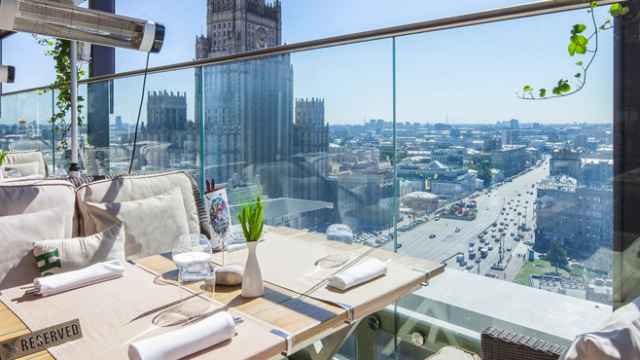“Space: The Birth of a New Era,” VDNKh’s most hyped exhibition of the year, is certainly setting its sights intergalactically high. Fortunately, visitors won't be disappointed.
This celebration of cosmonaut culture gathers together over 100 pieces of equipment, posters, spacesuits and interplanetary landers — many of which have never before left the walls of ultra-secretive organizations and private collections. That they are now exhibited together at VDNKh’s 100-meter-high classical empire-style Pavilion No.1 is nothing short of extraordinary.
A Spacefaring Nation
Although the United States put the first man on the moon, Russia has a long list of space firsts: the first satellite into orbit, the first animals into space, the first man — and woman — in space, the first space walk, and the first spacecraft landing on another celestial body. This year Russia celebrates the 55th anniversary of Yury Gagarin's flight.
The items on display are testament to these achievements. The Vostok 6 spacecraft — which carried the first woman into space — has to be one of the major draws. Spherical in structure and still bearing the scorch marks from its re-entry into the earth's atmosphere, it gives you some insight into the cramped conditions 26-year-old Valentina Tereshkova must have experienced during three days of hurtling around the earth’s orbit in 1963. Tereshkova’s mission was so secretive that she couldn’t even reveal the truth to her mother, who heard about her daughter’s exploits from a neighbor.
Meanwhile, in the grand, domed hall, visitors can gawk at the distinctly other worldly engineering model of the Lunokhod 3. The structure, which towers over guests, was the first spacecraft in the world designed to move on the surface of another planet.
The exhibition comes as VDNKh looks to expand its portfolio of museums. “Our exhibition marks the first step in creating a new attraction in Moscow, a dedicated space,” said Ekaterina Pronicheva, general director of VDNKh, in an interview with The Moscow Times. “In the next few years VDNKh will open its Space and Aviation Center, and we hope that the high quality that you can see in this exhibition will also characterize the museum. We want it to be the most modern and most interesting place to tell the world about the Russian dream of space exploration.”

LK-3 lunar lander (engineering model, 1969)
From London to Moscow
The journey to the current exhibition started over five years ago at the UK’s Science Museum. An unprecedented collaboration between ROSCOSMOS, ROSIZO and the United Rocket and Space Corporation allowed the original landers of the Vostok 6 and Voskhod 1 as well as the personal belongings of Yury Gagarin and Sergei Korolyov to travel to London where “Cosmonauts: The Birth of the Space Age” opened in 2015.
It was nothing short of a sensation. The tickets sold out several months before the exhibition even opened to the general public, and “Cosmonauts” was declared the most successful Science Museum Exhibition of all time when it closed earlier this year. While the current exhibition at VDNKh is based largely on the British concept — it worked with the Science Museum to bring “Space” to Moscow — it features even more exhibits and a bold, artistic layout.
Doug Millard, Curator of the Cosmonauts exhibition at the Science Museum, said, “Close collaboration with many individuals and institutions in Russia was crucial to the success of our Cosmonauts exhibition at the Science Museum in London. Now to be part of bringing much of that show to Moscow is tremendously rewarding.”

Soyuz TM-14
Pushing Boundaries
The exhibition documents humankind’s constant desire to push the boundaries of knowledge, from Konstantin Tsiolkovsky’s development of the mathematics of rocketry, to engineers establishing how to defy gravity and later, sending people into orbit. And it also documents the irrepressible human spirit: during this period in Russia's history, when so much was sanctioned and censored, dreams of cosmic grandeur flourished.
But the show is not all equipment: bold Soviet-era posters celebrate the achievements of Russia's cosmonaut heroes in striking graphic style, while drawings by Galina Balashova show her designs for the Soviet Union's rockets, orbital laboratories and shuttles. Her drawings, which brought architecture and a modicum of comfort to cosmic heights, are both fascinating from an artistic point of view and incredible historical documents.
“Our forefathers gazed at the stars, dreamed of bigger things and achieved even greater things. If we take one example from exhibitions like these, it’s that they teach us how we need to study, work and live, so that we can go even further,” said Vladimir Medinsky, the Russian Minister of Culture, at the opening of the exhibition.
Testing our limits would seem to be a human preoccupation. When you enter the final section of the exhibition you’re left with one question: Considering how far we've come, where will we go next?
Contact the author at artsreporter@imedia.ru
A Message from The Moscow Times:
Dear readers,
We are facing unprecedented challenges. Russia's Prosecutor General's Office has designated The Moscow Times as an "undesirable" organization, criminalizing our work and putting our staff at risk of prosecution. This follows our earlier unjust labeling as a "foreign agent."
These actions are direct attempts to silence independent journalism in Russia. The authorities claim our work "discredits the decisions of the Russian leadership." We see things differently: we strive to provide accurate, unbiased reporting on Russia.
We, the journalists of The Moscow Times, refuse to be silenced. But to continue our work, we need your help.
Your support, no matter how small, makes a world of difference. If you can, please support us monthly starting from just $2. It's quick to set up, and every contribution makes a significant impact.
By supporting The Moscow Times, you're defending open, independent journalism in the face of repression. Thank you for standing with us.
Remind me later.






